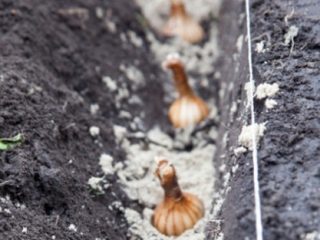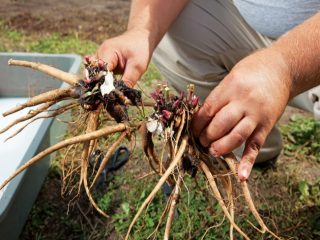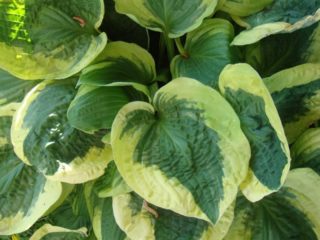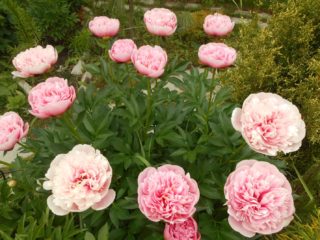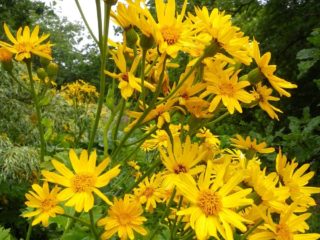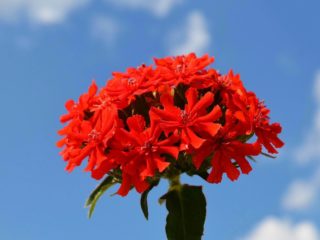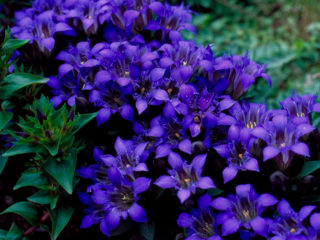Content
Rose Adelaide Hoodless (lat. Rose Canadian Adelaide Hoodless) is a variety characterized by fast growth, abundant flowering and ease of care. It was named after the Canadian reformer who was the founder of the Women's Institute.
History of selection
Rose Adelaide Hoodless appeared in 1972 in Canada. The originator of the variety is the Canadian Ornamental Plant Foundation! The variety was developed by breeder Henry H. Marshal by crossing interspecific and the hardiest varieties of roses.
Description and characteristics of the rose Adelaide Hoodless
Adelaide Hoodless is an interspecific hybrid belonging to the Canadian Hardy Roses group and the Parkland variety series. They include varieties that are winter-hardy and drought-resistant. Rose Adelaide Hoodless is a universal variety that is suitable for growing in any region.

The bushes overwinter without shelter and can freeze out only if the temperature drops below -40 °C
Park rose shrub Adelaide Hoodless is a flowering spreading bush 1 to 2 m high and about 1.5 m wide.The smooth and narrow stems reach about 150 cm in length. They bear dark green glossy leaves, ovoid in shape. There are no thorns.
Flowering occurs in two waves and lasts from early June to late September. During the first, the plant produces a larger number of buds. Between waves, the bush also blooms, but less abundantly and luxuriantly.
On each stem there are 5-15 flowers, collected in pyramidal inflorescences. Semi-double cup-shaped buds reach about 7 cm in diameter. Each of them has 10-20 wavy petals of a rich red or crimson hue. Fully opened buds have yellowish-orange stamens.

During different flowering periods, the shade of the petals may vary slightly
The flowers have an unobtrusive, pleasant aroma. The petals of faded buds become dull and gradually fall off. In their place, round fruits with small brown seeds are formed.
Advantages and disadvantages
Rose Adelaide Hoodles tolerates lack of moisture and temperature changes well.

Rose Adelaide Hoodles blooms profusely and for a long time even in regions with harsh winters
Pros:
- high winter hardiness;
- requires minimal care;
- attractive appearance;
- long flowering;
- cuttings take root quickly;
- can be planted in shaded areas;
- resistance to most diseases.
Minuses:
- exposed to attacks by harmful insects;
- needs support.
Recommendations for cultivation
Planting can be done in April-May or at the end of September, early October. It is recommended to plant plants in partial shade or on the sunny side in a place protected from drafts. The soil in the selected area must be fertile.
It is not recommended to place rose bushes in close proximity to certain plants, as they shade flowering bushes, can inhibit their growth and act as carriers of infections. Undesirable neighbors include:
- hydrangeas;
- dahlias;
- juniper;
- cherry;
- pear;
- raspberries;
- rowan
Before planting, it is recommended to place the seedlings in warm water for several hours. The site should also be prepared in advance. It is recommended to loosen the soil and add the following fertilizers:
- rotted manure;
- peat;
- compost;
- sand;
- peat.
In the selected area, you should dig holes about 60 cm deep. At their bottom you need to lay a layer of drainage and fertile soil with the addition of 50 g of superphosphate. Then you will need to place the seedling in the hole and carefully straighten the roots.

The optimal distance between plants is at least 1.5 m
The root collar should be located 3 cm above the soil surface. After planting, the plant should be watered abundantly.
Caring for the Adelaide Hoodless rose variety involves regular watering, timely pruning, and fertilizing. It is recommended to moisten the soil 2-3 times a week during dry periods. The rest of the time, watering should be done as the soil dries out. In autumn, the soil does not need to be moistened. It is recommended to use settled water at room temperature for irrigation. It is advisable to pour at least 10-15 liters under each bush.
It is recommended to apply fertilizer four times per season. Frequency of fertilizing:
- In May and June. Add ammonium nitrate at the rate of 40 g per 1 m2.
- In July.Fertilize the rose with superphosphate (30 g/1 m2).
- In August. Fertilizer is applied no earlier than three weeks after adding superphosphate. At the end of summer, feed the plant with potassium nitrate (30 g/1 m2).
Faded buds need to be removed. Sanitary and formative pruning is recommended to be carried out in late autumn. Weak branches will need to be shortened, and old and strong branches will need to be completely removed to stimulate the growth of new shoots.

There is no need to cover the rose for the winter; at the end of the season, it is enough to just hill up the bushes.
Reproduction methods
The Adelaide Hoodless rose variety is propagated by vegetative methods. Most often cuttings are used. When the second wave of flowering begins, shoots are cut off from young bushes. There should be only two leaves left on each of them, the rest should be cut off. Then the cuttings are immediately planted in open ground.

To ensure that the cuttings overwinter safely, it is recommended to cover them with plastic bottles.
You can propagate the Adelaide Hoodless rose by dividing the bush. It is recommended to carry out the procedure in the spring before the buds begin to bloom. The plant should be dug up and divided so that each part has developed roots and several branches.

It is advisable to shorten the shoots and sprinkle the cut areas with crushed charcoal.
After planting, it is recommended to water the bushes abundantly and cover them with moist soil.
This variety of rose can also be propagated by layering. To begin with, in the spring you should dig a small hole near the bush. Then you will need to select long annual shoots and cut off the bark on them in the places where the leaves grow. The prepared branches need to be bent to the ground, lowered into the holes and buried. During the summer they need to be watered periodically.In the fall, the shoots should be dug up and placed in fertile soil for growing. Next year they can be transplanted into a flower bed.
Diseases and pests
Rose Adelaide Hoodless may be attacked by pests. Insect control methods:
- Scale insects. To combat these insects, it is recommended to use a soap solution.
It’s good to spray rose bushes with soapy water, even for preventive purposes.
- Rose leaf roller. First, you will need to tear off the affected leaf blades, and then treat the plant with insecticides, for example, Aktara, Liber.
If there are few pests, you will be able to do without the use of chemicals; it is enough to collect the caterpillars by hand
- Thrips. Affected bushes and the soil around them should be treated with insecticides; Intavir or Iskra work best against this parasite.
In autumn, it is additionally recommended to carry out preventive treatment
- Aphid. It is recommended to spray the plant with a soap solution and then treat it with any insecticide.
The appearance of aphids requires drastic measures; the pest multiplies very quickly
Application in landscape design
Rose Adelaide Hoodless is used to create hedges, decorate flower beds or mixborders. This profusely flowering plant looks good both in single and group plantings.

Rose Adelaide Hoodles goes well with decorative foliage plants
The rose bush looks good in any part of the garden and looks original in a composition with almost any plants.

Adelaide Hoodles fits especially well into landscape design in English and French styles
Conclusion
Rose Adelaide Hoodless is an unpretentious variety that is perfect for beginning gardeners. If you follow simple rules of agricultural technology, the plant will bloom regularly and profusely for many years, decorating your garden plot with its bright buds.
Reviews of rose Adelaide Hoodless




